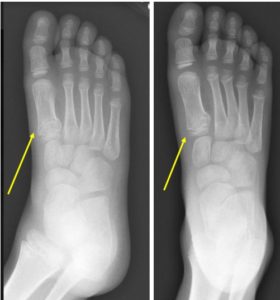Published on
Differential Diagnosis
- Salter type II fracture
- Cuboid fracture
- Navicular compression fracture
- Compartment syndrome
- Impacted fracture at the base of the first metatarsal

Diagnosis
This patient was diagnosed with an impacted fracture at the base of the first metatarsal, with buckling of cortex on AP view and impacted cortical discontinuity noted on oblique view. This injury is also known as a bunk bed fracture (pediatric Lisfranc).
Learnings/What to Look for
- This is a common pediatric fracture, but one that is often overlooked due to the subtle deformity of the proximal first metatarsal
- Mechanism of injury is typically a fall from a sufficient height, resulting in a flexion force that wedges the oblique first cuneiform-first metatarsal epiphysis into the first metatarsal-second metatarsal interspace
- The injury is more severe than indicated by the bone injury, in that ligaments are involved in subluxation
- The pathogenesis of adult Lisfranc tarsometatarsal dislocation is the model for the pediatric equivalent
Pearls for Urgent Care Management and Considerations for Transfer
- If the injury is limited to a nondisplaced fracture, management is conservative (immobilization and appropriate pain management)
- Displaced fractures (or any more complex injury involving tarsometatarsal joints) often require surgery with closed or open reduction, internal fixation, and immobilization
Acknowledgment: Images and case provided by Experity Teleradiology (www.experityhealth.com/teleradiology).
A 6-Year-Old Boy with Foot Pain After Tripping a Day Earlier
1 2
